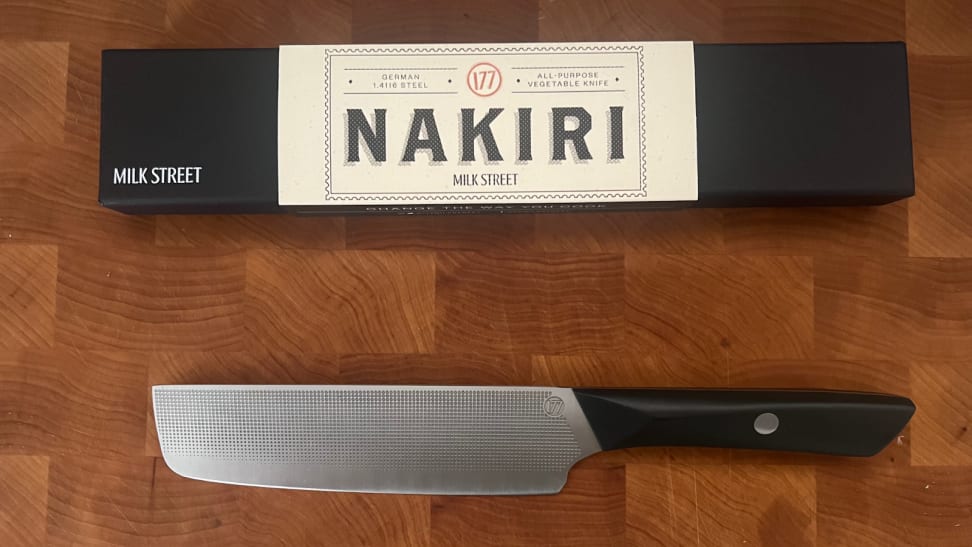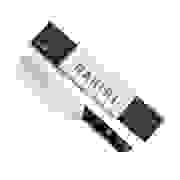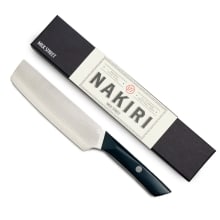Milk Street Nakiri Review
The Nakiri knife from Milk Street could stand in for your chef's knife—sometimes
 Credit:
Reviewed / Daniel Modlin
Credit:
Reviewed / Daniel Modlin
Products are chosen independently by our editors. Purchases made through our links may earn us a commission.
-

Milk Street Nakiri
Pros
-
Lightweight
-
Nonstick blade
-
Comfortable
-
Inexpensive
Cons
-
Not designed for tough ingredients
-
Dulls easily
-
If you don’t have a Nakiri knife, you really should. This Japanese blade style is adept at cutting foods like veggies, thanks to its rounded-off edges, lightweight build, and cleaver-like design.
Beyond its shape, a Nakiri knife is also meant to be lightweight—not too lightweight that it can’t cut through a potato, but lightweight enough that it can easily glide through scallions and the like. The renowned Milk Street Nakiri Knife is a great pick for anyone in the market for that style because it has a few handy features that make it stand out from the pack.
About The Milk Street Nakiri Knife

The Milk Street Nakiri knife is a beautiful blade.
When compared against knife giants like Wüstof, Henckels, and Shun, the Milk Street brand is relatively unknown.
But Christopher Kimball, one of the founders of America’s Test Kitchen and the founder of Milk Street, certainly knows what’s what when it comes to great kitchen tools. And the brand’s Nakiri is no exception.
This Nakiri knife is one of the lightest of this style available on the market—weighing in at just 6.2 ounces. It has a 6.5-inch blade, a standard size for the knife style.
But what’s not so standard is how thin the blade is: At just 1.6 millimeters (and tapering down), this blade is razor-thin, one of the reasons it weighs so little.
The blade also comes with a few more features, including an ergonomic, riveted handle and a nonstick coating on the blade that's designed to help keep vegetables from sticking to it while cutting.
How we tested The Milk Street Nakiri

We chopped everything in sight with the milk Street Nakiri Knife.
To test the Milk Street Nakiri, I used the blade at home for two weeks, getting a feel for it over time while using it to chop a variety of different foods.
I ran a paper cutting test to evaluate its sharpness, cut through chicken breast, tomatoes, butternut squash, and parsley to see how easy it was to get a fine cut through different textures.
I also evaluated it against other knives based on aesthetics and comfort. And over time, I was able to see if the blade dulled much during testing.
What we like about The Milk Street Nakiri

This multipurpose Nakiri knife is comfortable and versatile.
It’s lightweight
One of the most notable features of the Milk Street Nakiri is how lightweight it is. Light as a feather, this knife made otherwise tedious tasks like cutting through tomatoes and parsley a breeze.
Thanks to the ergonomic handle and the overall shape of the blade, this made prepping dinner every night much easier and less strenuous than with other knives.
The blade's nonstick coating really works
I was skeptical of the promise of a blade with nonstick coating at first. But I was proven wrong: When chopping carrots, the food really just slid right off the top of the blade.
This offered more control, helping me focus on what I was chopping next instead of having to slide ingredients off the blade (potentially cutting myself in the process).
It’s reasonably priced
At just about $80, the Milk Street Nakiri is about the same price as a Wüsthof knife, and about half the price of a Shun.
This pricing makes it great for entry-level cooks who are looking to explore the Nakiri shape without spending hundreds on a blade from a high-end brand.
What we don’t like

Tough ingredients might not be meant for this blade.
It struggles with tougher ingredients
Most likely because of the weight, I found this Nakiri to fall short with tough ingredients like potatoes. It got stuck several times instead of slicing right through them.
Even though this knife may look like a cleaver, it's not. This blade is certainly meant for more delicate work, which means you'll have to save your tougher ingredients for a sturdier chef's knife.
It dulls easily
While the blade first passed the paper test with flying colors, by the end of two weeks, it was rather dull.
A blade like this is easy to sharpen, but it’s worth noting in case that’s not something you want to commit to or have time for.
Should you buy the Milk Street Nakiri Knife?
Yes, especially if you’re Nakiri-curious
At $80, the Milk Street Nakiri Knife is a great investment for those looking to explore this knife style.
The lightweight nature of the blade makes it great for beginners, as does the nonstick coating on the blade itself. It is precise, nimble, and excellent for small, precision-oriented kitchen tasks like slicing veggies.
Of course, it’s not the nicest Nakiri out there. If you really are looking for something exquisite, the Shun Premier Nakiri Knife is sturdier and promises more longevity—but for a higher price.

An excellent beginner blade in the Nakiri knife category.



